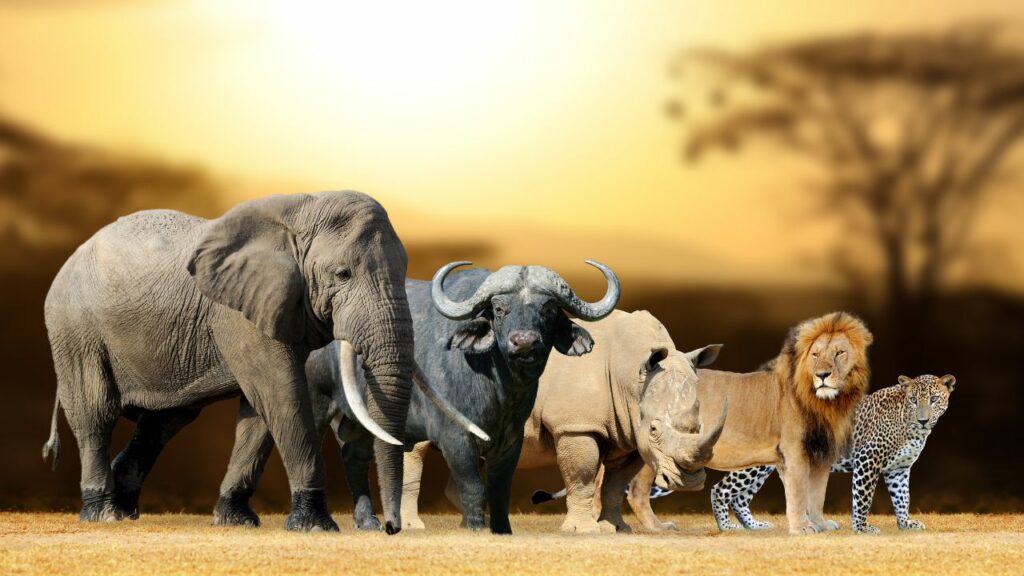On every Africam in South Africa, Zimbabwe and Kenya, you’ll see the ‘big five’ animals. Elephant, rhino, buffalo, lion and leopard. The term was coined by big game hunters more than 100 years ago as the five most difficult animals to hunt. It stuck, and is now used as a safari term to reference the most popular game sightings you see on a safari. Let’s learn more about these incredible wild animals.

Elephants (Loxodonta Africana)
African savanna elephants are the largest land mammals in the world and are one of two Loxodonta species found in Africa, the other being the forest elephant (Loxodonta cyclotis). Bulls stand, on average, at 3 m at the shoulder and weigh up to 6 tonnes; the most exceptional specimen ever recorded stood 4.9 m tall at the shoulder with a weight of 10 tonnes! Females, on average, stand 2.5 m high and weigh up to 3 tonnes.
African savanna elephants have large, visible tusks (unlike asian elephants that have small ‘tushes’ that don’t often protrude like that of the African elephant); bulls grow larger and heavier tusks than females and those whose tusks reach lengths of 1.5 m or more are referred to as ‘tuskers’.
Tusk length and weight is variable but the record stands at 3.5 m long with a weight of 117 kg. The tusks are used for defending and attacking but are also a useful tool for striping bark, digging and breaking trees.

Black Rhinos (Diceros bicornis)
The black, or hook-lipped, rhinocerous is a critically endangered large mammal whose range has been reduced to the southern half of Africa. At one time, its range stretched to west Africa and terminated south of the Sahara.
The obvious difference between the black and white rhinocerous is the shape of the mouth; white rhinos have a square mouth and are now commonly referred to as square-lipped rhinos, while the black rhino has a hooked upper lip and is now commonly referred to as the hook-lipped rhino.
Black rhinos are also smaller than white rhinos with a typical weight of between 800 and 1400 kg – exceptional male specimens weighing almost 2900 kg have been recorded but are unusual. Males are heavier than females.
Black rhinos have thinner and pointier horns than white rhinos; the longer front horn of a black rhino is 50 cm long on average, but a length of up 140 cm has been recorded. Despite being commonly called black rhino, they are not black, their skin varies from grey to brown.
White Rhinos (ceratotherium simum)
White rhino are the second largest land mammal on Earth and are part of the group known as the ‘big five’, a term coined by hunters to describe the most dangerous animals to hunt on foot. There are two subspecies of white rhino, the southern white rhino which is considered near-threatened but whose population is in decline and the northern white rhino which is critically endangered.
South Africa has 93% of the southern white rhino population. Males weigh up to 2300 kg while females weigh up to 1700 kg.
These are stocky animals with a short neck and short legs. Their heads are large with two horns on the snout made of keratin; the front horn is long, averaging 60 cm but may be as long as 150 cm, the second horn in short and sits behind the long front horn. Females tend to have thinner and longer horns than males whose horns are bulkier.
The white rhino has a wide muzzle and a square mouth with a stiff bottom lip which the flexible upper lip manoeuvres grass onto to be cropped. Their eyes are small and they have poor vision, but they make up for this with excellent hearing facilitated by funnel-like, independently moving ears. Their sense of smell is also excellent.
White rhino have a prominent muscular hump that supports their large head and holds it close to the ground for grazing and picking up olfactory (scent) cues. Their skin grey and creased, and despite their large size, are able to charge at a speed of up to 40 km/h.

Buffalo (Syncerus caffer)
The African or Cape buffalo held the reputation as the most dangerous of the big five. Weighing up to 900 kg, this stocky bovid is notoriously temperamental, especially older ‘dagga-boys’ who break away from the herd and are easily provoked to charge without warning.
Both sexes have horns; males are heavier than females, have larger horns with a ‘boss’ (a thick, hard helmet-like structure where the horns attach to the head, it is often caked with mud) and are slightly darker. Both sexes have large, hairy ears that fall below their horns. They may live up to 23 years. Old individuals have white patches around the eyes and on the body.

Lion (Panthera leo)
Lions are the biggest cats in Africa, an apex predator and a keystone species. These social felids show the most sexual dimorphism amongst the big cats; males weigh between 175 to 225 kg and form an iconic mane around their necks, and females weigh between 120 to 145 kg.
Lions hold the highest muscle mass of all mammals at 58.8%. Fur colour can vary from a light tawny to yellow-brown. Cubs are born with darker spots that fade as they get older. Same lions may have these faded blotches on their legs even into adulthood. The tail has a dark brown tuft on the end.

Leopard (Panthera pardus)
Leopards are one of the most striking and iconic animals in Africa. They are elusive and stealthy, and they spend a lot of time in trees. Their stocky but elegant bodies are adorned with dark spots arranged around a patch of red-gold fur – each of these is called a rosette. Their heads and legs have solid black spots. Their faces are proportionate with long vibrissae (whiskers), and their eyes have round pupils.
Males, which weigh up to 90 kg, are larger and bulkier than females who weigh up to 50 kg. Leopards are mostly crepuscular and do the majority of their hunting between dusk and dawn.
As solitary animals, adult leopards come together to mate or during territorial battles; though, it is very likely that leopards recognise their kin, which they are less aggressive toward, even into adulthood; this is evident from numerous sightings of males associating with the cubs of females they’ve mated with, several generations of females feeding off the same kill and, on one documented occasion, eight leopards were seen together in a single sighting in the Sabi Sand reserve in South africa.






